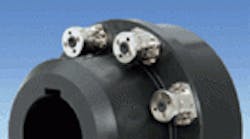Safety is arguably the most important design objective there is. Productivity begins with making sure operators and machinery can operate in a safe and sound working environment. Here are some of the newest components and tactics to help protect your future designs.
Couplings protect and then reengage
Compact and versatile ST1 torque limiters protect industrial equipment from failure due to torque overload. A modular design allows complete breakaway at widely adjustable torque levels, from 737 to 118,000 ft-lb across four body sizes, and to 306,000 ft-lb for special applications. Couplings can be mounted inline with universal drive shafts or mounted to sprockets, pulleys, gears, and sheaves. A key feature of the ST series is fast and simple reengagement: After overload and disengagement, individual plungers may be easily snapped back into engagement. No shear pins, hydraulic fittings, or other parts are required.
R+W America
(888) 479-8728
rw-america.com/products/torque_limiters/high_torque/
Machine guards for simple and foolproof safety
Machine guards and physical barriers are a reliable, versatile, and economical method of protecting people from automated equipment. System flexibility allows easy integration of access doors and interlocks. Compared to sophisticated sensor-based devices, physical machine guards are always on duty, unaffected by power outages or electrical problems. The Rapid Guard Lift System, pictured, installs 50% faster than conventional machine guards and meets all OSHA and RIA safety standards. Two stock heights and 12 stock doors ship within 48 hours; custom designs also available.
WireCrafters LLC
(800) 626-1816
wirecrafters.com
Micro drives can remove power from motor
Series 3G3MX2 ac micro drives are available with 230 or 460 V and power ranges from fractional to 20 hp. Sensorless vector control and built-in safety inputs make the drives suitable for constant-torque conveyor and mixing applications, and easy to integrate into new or existing safety systems. Embedded safety circuits provide “safe torque off” operator protection conforming to ISO 13849-1, Cat 3. This removes power from the motor, allowing it to coast to a stop while the drive is still powered. Communication options include Modbus, DeviceNet, Profibus, EtherCAT, Mechatrolink-II, and others.
Omron Electronics LLC
(866) 88-OMRON
omron247.com
Microcontrollers include safeguards in hardware
The Hercules safety microcontroller platform for medical, industrial, and transportation applications consists of three ARM Cortex-based microcontroller families that offer scalable performance, connectivity, memory, and safety features. Unlike many microcontrollers that rely heavily on software for safety capabilities, Hercules controllers include safeguards in the hardware itself for maximum protection. An extensive safety manual details how to implement the Hercules family into safety-critical applications. Hercules MCU families include the RM4x, TMS570, and TMS470M, each offering different capabilities.
Texas Instruments Inc.
(972) 644-5580
ti.com/hercules-tools-pr
Light curtains offer integral muting
The EZ-Screen Low-Profile Safety Light Curtain with Integral Muting is designed for use on smaller production machines, featuring high performance in compact spaces. The two-piece optoelectronic safeguarding device creates a screen of synchronized, modulated infrared sensing beams that extend from end-to-end of the housing, ensuring workers are protected from machine safety hazards. Sensing range spans from 4 to 23 in. Seven predefined muting options are available, including bypass, mute-dependent override, mute enable, and others.
Banner Engineering Corp.
(888) 373-6767
bannerengineering.com
Safety Relays Simplified
Safety relays may be rather basic and humble electronic components, but they nevertheless fall into the category of essential, mission-critical parts. In fact, safety relays with force-guided contacts are the core building blocks of sophisticated safety devices and are indispensable when designing safety circuits. Ultimately, these safety devices are designed to protect workers and machinery as demanded by regulations such as OSHA CFR 1910 General Requirements for All Machines and the European Machinery Directive EMD 89/392/EEC, and are therefore vital to modern manufacturing processes.
Safety relays: How they work
A safety relay contains force-guided contacts, also known as captive, locked, or positive-guided contacts. Force guidance in a relay means that the contacts in a contact set must be mechanically linked together so that it is impossible for the NO (normally open) and NC (normally closed) contacts to be closed at the same time. The contacts are linked so that no single contact in a relay can change state without changing all the contacts in that relay. Further, there must be a 0.5-mm minimum air gap between the open contacts for the entire service life of the relay, even in the event of a failure. The force guidance of the relay contacts must always be preserved even if a relay part fails to function correctly.
Typical applications for safety relays include use in emergency stop (E-stop) modules, DIN rail safety modules, safety door controls, two-hand operating devices, light barriers and curtains, and speed controls. Safety relays are also found in larger machinery and equipment control systems for elevators and escalators, cranes, printing machinery, robots, medical equipment, and stamping and cutting machines.
To fully understand how these safety relays do their work, it's useful to be familiar with basic terminology:
Coil, relay: One or more windings on a common form.
Contact gap: The final length of the isolating distance between mating contacts when the contacts are open.
Contact arrangement: The combination of contact forms that make up the entire relay switching structure.
Contact material: Substance or combination of substances used as constituents in the manufacture of contacts. Typical materials include silver-tin dioxide or silver-nickel combinations coated with a thin layer of gold.
Crown contacts: A superior contact form that enforces high contact stress on at least two spots on the contact — to penetrate any built-up contamination, maintain low contact resistance throughout the relay's life, and increase the switchable output voltage.
Force-guided contacts: Electromechanical relay contacts mechanically linked together, so that when the relay coil is energized or de-energized, all linked contacts move together.
This month's handy tips courtesy of Altech Corp., (908) 806-9400,altechcorp.com.
